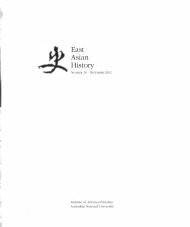Mujaku Dochu (1653-1744) and 17th-Century ... - East Asian History
Mujaku Dochu (1653-1744) and 17th-Century ... - East Asian History
Mujaku Dochu (1653-1744) and 17th-Century ... - East Asian History
Create successful ePaper yourself
Turn your PDF publications into a flip-book with our unique Google optimized e-Paper software.
MUJAKU DOCHO<br />
31<br />
sanitaire around Chinese Buddhism imposed by the Yi dynasty court. In<br />
Japan similar policies were adopted only towards popular Nichiren B<br />
sects such as Fujufuse /f§'t/fnffi. Korean monks who tried to go to<br />
Ming or Ch'ing China, <strong>and</strong> those who did <strong>and</strong> returned, were certain to<br />
be executed.33 And, with possible minor exceptions, Korean Buddhists<br />
had no curiosity about Japanese Buddhism, probably considering it a<br />
mere extension, <strong>and</strong> hence an adulterated form, of Chinese <strong>and</strong> Korean<br />
Buddhism <strong>and</strong> so not worth attention.<br />
Thus, while Korean Buddhism was perforce inward-looking <strong>and</strong> relatively<br />
stagnant, not enlivened by fresh external input, Japanese Buddhism<br />
was alive with reforms, new ideas <strong>and</strong> volumes of information from China<br />
<strong>and</strong> Korea. This is evident even in the reading <strong>and</strong> library of <strong>Mujaku</strong>, an<br />
admittedly bibliophilic, scholarly Rinzai Zen monk. Yet this evidence flies<br />
in the face of the accepted theory of a stagnant <strong>and</strong> hidebound Buddhism<br />
in the Tokugawa era.<br />
Japan had several main avenues for the importation of new Buddhist<br />
knowledge. The first, in the early half of the Tokugawa, were refugees<br />
from Ming China, in particular the monks from Mount Huang-po, that is,<br />
the Obaku monks. The first Chinese Lin-chi monk to arrive in the Tokugawa<br />
was Tao-che Ch'ao-yUan mJm7t (d. 1660), who stayed in Japan<br />
from 1651 to 1658, when he was consulted by a number of Rinzai <strong>and</strong> Soto<br />
monks. The last Chinese abbot died at Manpukuji in 1784, although most<br />
of these Chinese had come as young monks to Japan <strong>and</strong> trained there.<br />
The last Chinese abbot had arrived in Japan in 1721 <strong>and</strong> became abbot in<br />
1775.3 4 Thus there were lines of personal communication from China until<br />
the 1720s, unlike in Korea, where no Chinese monks had been permitted<br />
to set foot since the start of the fifteenth century.<br />
Yet, unlike many of his Zen monk contemporaries, <strong>Mujaku</strong> had virtually<br />
no direct contact with the Chinese Obaku monks, especially after<br />
his master, Somon, died. <strong>Mujaku</strong>'s relations with Obaku were complex,<br />
partly because Somon, who had done much to assist Yin-yUan Lung-ch'i<br />
(1592-1673) gain patronage in Japan <strong>and</strong> who, along with Ryukei Shosen<br />
¥'l1m, had campaigned to have Lung-ch'i made abbot of Myoshinji,<br />
felt betrayed by Shosen's defection to the Obaku lineage <strong>and</strong> by Lungch'i's<br />
arrogance <strong>and</strong> ingratitude. Moreover, Lung-ch'i <strong>and</strong> several other<br />
Chinese monks failed to adapt to Japanese protocol. It is likely <strong>Mujaku</strong> was<br />
jealous of the lavish patronage given to Lung-ch'i <strong>and</strong> Shosen, <strong>and</strong> in 1697<br />
he removed the names of Shosen <strong>and</strong> some seventeen pro-Obaku monks<br />
from the genealogical register of Myoshinji.35<br />
Yet at the same time, <strong>Mujaku</strong> sustained a friendship with Saiun Doto<br />
(1673-1713), who had been Lung-ch'i's attendant.3 6 Although <strong>Mujaku</strong> may<br />
have briefly visited some of the Obaku monasteries, he only seems to have<br />
had relations with Doto.37 Doto, then named Yuiryan 'I'lffit, visited Somon<br />
33 John Jorgensen, "Problems in the Comparison<br />
of Korean <strong>and</strong> Chinese Buddhism:<br />
From the 16th <strong>Century</strong> to the 19th <strong>Century</strong>," in<br />
Korean Buddhism in <strong>East</strong> <strong>Asian</strong> Perspectives,<br />
compo Geumgang Center for Buddhist Studies<br />
(Seoul: Jimoondang, 2007), pp.131-35, 141,<br />
147.<br />
34 Baroni, Ohaku Zen, pp.65; Hayashi<br />
Yukimitsu, Ohaku bunka [Obaku Culturel<br />
CUji: Manpukuji, 1972), p.140.<br />
35 Jorgensen, "Zen Scholarship," pp.2, 4-7,<br />
10.<br />
36 Jorgensen, "Zen Scholarship," pp.18-21.<br />
37 Lin, "<strong>Mujaku</strong> <strong>Dochu</strong>," pp. 24-5.

















